Codependency Defined
Codependency is a multifaceted and often misunderstood concept that describes a psychological and behavioral pattern characterized by an unhealthy, interdependent relationship between two or more individuals, often family members or people in romantic codependent relationships. Codependency refers to situations where one person, often referred to as the “codependent person,” relies excessively on another person, known as the “enabler,” for emotional, psychological, or even physical support.
Codependency is often used synonymously with relationship addiction, although this is a distinct concept. It also co-occurs frequently with with substance abuse disorders. This dynamic is not limited to romantic relationships; it can also occur within families, friendships, or professional settings. Codependency is a deeply ingrained behavior pattern that can have profound consequences on an individual’s mental, emotional, and physical well-being.
Codependency often arises from a combination of factors, including low self esteem, unresolved childhood trauma, and a desire for external validation. It is essential to note that codependency is not a formal diagnosis in the Diagnostic and Statistical Manual of Mental Disorders (DSM-5), but it is recognized as a pervasive issue in the field of psychology and mental health.
In essence, codependency is a set of behaviors and beliefs that reflect a maladaptive way of relating to others, and it can manifest in various forms and degrees of severity. It is not impossible to overcome codependency, but it is difficult. Treatment at a licensed mental health facility like Turning Point of Tampa can be helpful for people involved in codependency, particularly those who also struggle with substance abuse or another diagnosable mental health condition.
What is A Codependent Relationship?

A codependent relationship is a type of dysfunctional and often unhealthy interpersonal relationship in which two or more individuals in interpersonal relationships are excessively emotionally or psychologically dependent on each other. This can ultimately result in a chemical dependency, where the individuals involve become addicted to the chemical signals they receive from the repeated interactions they have in their codependency patterns.
In a codependent relationship, there is insufficient differentiation (a psychological concept that means distance) between the two people involved. This means the addicted person cannot differentiate their own feelings from those of the person they are codependent with. Codependent behaviors and codependent tendencies emerge from this challenge, and mental health professionals identify the lack of differentiation as the source of these dysfunctional relationships.
What this means is that one person cannot distinguish their wants and needs from the other. A codependent relationship and codependent tendencies can manifest in romantic relationships, family dynamics, friendships, or professional relationships. Dysfunctional families are more likely to experience codependency, and people in dysfunctional families will often exhibit codependent behavior later in life, as it is a learned behavior. People who have a codependent parent or multiple codependent parents are much more likely to have poor boundaries and codependent behaviors later in life. Furthermore, codependency is not a static condition; it can change and evolve over time, potentially becoming more pronounced or less severe.
Codependent relationships are generally considered unhealthy and detrimental to the well-being of the individuals involved. They can perpetuate underlying emotional and psychological issues and inhibit personal growth and self-discovery. Recognizing and acknowledging a codependent relationship is the first step toward addressing and potentially changing the dynamic.
Signs of Codependency

Recognizing signs of codependency can be helpful for people who are concerned about codependency in their own lives or those of the people around them. The following are some major signs of codependency to be aware of.
Excessive Reliance:
The codependent person places an excessive reliance on the enabler for emotional support, validation, or even day-to-day decision-making. They may feel a deep need for the enabler’s approval and validation to the detriment of their own already low sense of self. This need for approval is one of the defining signs of codependency.
Lack of Boundaries:
Healthy senses of boundaries between people are often missing in codependent relationships. Both individuals may have difficulty establishing and maintaining boundaries, which can lead to enmeshment and blurred lines between their identities and needs.
Self-Neglect:
Codependents often prioritize the enabler’s needs and well-being above their own, often neglecting self-care and their personal interests. They may engage in self-sacrificing behaviors to maintain the relationship.
Enabling Behaviors:
The enabler in a codependent relationship often engages in enabling behaviors, such as accommodating the codependent’s demands, protecting them from consequences, or ignoring their own needs to maintain the status quo.
Emotional Turmoil:
Codependent relationships can be marked by emotional turmoil, including anxiety, guilt, anger, and frustration. The relationship may create a rollercoaster of emotions, leading to stress and unhappiness, but the codependency may only accelerate as each person becomes less secure in their own feelings and life pursuits.
Limited Autonomy:
Both individuals may have difficulty making independent decisions or pursuing their personal goals. The codependency often stunts personal growth and development.
Risk Factors for Codependent Relationships

While the indicators listed above can be a sign that someone is a dependent person or is otherwise involved in a relationship that involves codependency, there are also risk factors that a person should be aware of that may arise in relationships.
Family History:
Growing up in a family where codependent behaviors were present or where substance abuse was prevalent can increase the risk of developing codependency. Children who were exposed to codependency in their family of origin may adopt these behaviors in their own relationships.
Early Trauma:
Experiencing traumatic events in childhood, such as physical, emotional, or sexual abuse, can lead to codependency as a coping mechanism. Individuals who had to adapt to challenging or unpredictable family environments may develop codependent patterns as a means of survival.
Low Self-Esteem:
Individuals with low self-esteem are more susceptible to codependency. They often seek external validation and may have difficulty asserting their own needs and boundaries. A lack of self-worth can make one more reliant on others for a sense of value.
Insecurity:
Deep-seated feelings of insecurity or inadequacy can drive individuals toward codependency. They may believe they need another person to provide a sense of security and happiness, leading to an overreliance on their partner or loved ones.
People-Pleasing Tendencies:
A strong desire to please others and fear of rejection can lead to codependency. Individuals who prioritize others’ needs and desires over their own, often to an extreme extent, are at risk of becoming codependent.
Lack of Healthy Role Models:
Growing up without positive role models for healthy relationships and boundaries can make it challenging for individuals to recognize and establish those boundaries themselves. They may not have learned how to maintain autonomy while also fostering intimacy.
Substance Abuse or Addiction:
Individuals who struggle with substance use or addiction issues are at a heightened risk of developing codependency. Codependency can often be intertwined with enabling behaviors in such relationships.
Fear of Abandonment:
A strong fear of abandonment can drive individuals to maintain codependent relationships, even if they are unhealthy or harmful. This fear can make them reluctant to assert themselves or seek independence.
Lack of Self-Awareness:
Some individuals may be unaware of their codependent tendencies or have trouble recognizing that their behaviors are problematic. Without self-awareness, it can be challenging to address and change codependent patterns.
Unresolved Grief or Loss of Family Members:
Experiencing significant losses or unresolved grief can lead to codependency, as individuals may seek to fill the emotional void left by these losses through their relationships. A codependent person may seek to fill the void left by family members who have passed away with their relationship with the person who enables them.
Mental Health Conditions That May Affect A Codependent Person
While codependency refers to a condition that does not always arise to a level of impairment requiring the involvement of clinical psychology, there are some conditions that often affect people with codependency. These include substance use disorders and personality disorders.
Substance Use Disorders
The relationship between codependency and substance use disorder is intricate and often interwoven, as individuals struggling with codependency are at an increased risk of becoming involved in, or enabling, substance use or addiction in their loved ones. This dynamic can be detrimental to both the codependent individual and the person with substance use issues.
Enabling Substance Users:
Codependency sufferers tend to prioritize the needs and well-being of others, often to an extreme extent. When a loved one is dealing with substance use issues, a codependent individual may engage in behaviors that enable that person, such as covering up the addiction, making excuses for the addict, providing financial support, or minimizing the consequences of the addiction.
Emotional Dependency:
Codependent people often seek validation and a feeling of personal worth through their relationships. When a loved one is struggling with substance use disorder, the codependent may tie their emotional well-being to the addict’s actions and behaviors.
Recreating Family Pathologies:
In some cases, codependency is learned in childhood from living in a dysfunctional family where substance use or addiction was present. This learned behavior can be passed down through generations, with codependent children growing up to become codependent adults who are drawn to relationships with substance abusers.
Fear of Abandonment:
Many codependents fear abandonment or rejection. This fear can make them reluctant to confront the substance use issue or set healthy boundaries with the addicted loved one for fear of driving them away, but this caring behavior ironically prevents the creation of a mutually satisfying relationship.
Cycles of Dysfunction:
Codependency and substance use often exist in a cycle of dysfunction. The substance abuser’s behavior may worsen due to the codependent’s enabling, and the codependent may become increasingly dependent on the addict for validation and purpose. Building a healthy relationship depends on developing healthy interdependence and avoiding the circular relationship that characterizes these cycles.
Personality Disorders
Dependent Personality Disorder
Dependent Personality Disorder (DPD) is a mental illness characterized by a pervasive and excessive need for others’ support, approval, and guidance.
Individuals with DPD fear rejection and abandonment, going to great lengths to maintain relationships, even if they are unhealthy. These lengths include making extreme sacrifices for the people they care about. While codependency exists in people who do not have a clinical diagnosis like DPD, codependent people tend to suffer from DPD at higher rates.
People with DPD often succumb to submissiveness in relationships, going along with others’ wishes to avoid conflict and changing their own behavior to accommodate others, often romantic partners. This may be known as pathological altruism.
They frequently feel overly sensitive to criticism or disapproval, often internalizing blame. This limits a person’s ability to choose what they want, and they often feel responsible for others’ pain.
DPD often emerges from a dysfunctional family. It can hinder personal growth and independence. Treatment, typically involving psychotherapy, helps individuals with DPD develop self-reliance and healthier relationships while addressing their fears of abandonment. Treatment may incorporate their codependent partner to address their relationship dynamics, or may focus solely on their own emotions and their own behavior.
Borderline Personality Disorder
Borderline Personality Disorder (BPD) is a complex and often debilitating mental health condition characterized by unstable moods, self-image, and relationships. Individuals with BPD frequently experience intense emotional swings, impulsivity, and an unstable sense of self. They may struggle with feelings of emptiness, engage in self-destructive behaviors, and have tumultuous relationships.
Codependency can be intertwined with BPD in various ways. Codependent individuals often find themselves in relationships with those suffering from BPD, as they are drawn to people who need their support. Mental Health America notes that BPD and codependency are frequently tied to one another.
Codependency Treatment and Turning Point of Tampa
Breaking free from the codependency cycle can be challenging, but it is essential for the well-being of both parties. Professional help, such as therapy, support groups, and addiction treatment, can be beneficial for both the codependent and the individual struggling with substance use disorder. In groups like Co-Dependents Anonymous, members suffer from similar issues, and can help people learn to build self esteem and recognize how their behavioral patterns and tendency toward self sacrifice are ultimately hurting them and their loved ones.
Turning Point of Tampa works with families, friends, and loved ones that are important to the person in treatment. In family therapy or relationship therapy, individuals with codependency can explore their enabling behaviors, work on establishing healthier boundaries, and develop a sense of self-worth that is independent of their role in the addicted person’s life.
While addressing addition, an eating disorder, or co-occurring disorder is what Turning Point of Tampa treats daily, it is important to note many in treatment add codependency to their treatment plan. Clinicians help those in our care learn and understand how to address their own codependency.
Frequently Asked Question
What is a codependent person like?
A codependent person often exhibits excessive emotional or psychological reliance on a partner, typically one who requires support due to an illness or addiction.
What is the main cause of codependency?
The main cause of codependency is often rooted in early family experiences, where a person learns to put others’ needs before their own to the point of having a poor sense of self.
Do codependents really love?
Codependents can love, but their expression of love may be driven by an urge to fix, heal, or save someone, which can lead to an unhealthy dynamic.
How do you fix codependency?
Fixing codependency often involves setting boundaries, developing a stronger sense of self, engaging in therapy, and practicing self-care.
What are the five core symptoms of codependency?
The five core symptoms of codependency are low self-esteem, people-pleasing behaviors, difficulty setting boundaries, caretaking, and dependency.
How does a codependent person act?
A codependent person may act submissive, needy, clingy, or try to control others to feel secure in a relationship.
How do you break codependency?
Breaking codependency typically requires therapy, self-help groups, learning to set boundaries, and practicing assertiveness.
How can I tell if I’m codependent?
You might be codependent if you find it hard to be alone, manage an excessive need to please others, or base your self-worth on caretaking.
What triggers a codependent person?
A codependent person can be triggered by the real or perceived needs of others, feelings of neglect, or situations where their help is refused or not needed.
What makes a person codependent?
A person becomes codependent usually due to their upbringing, particularly if they were raised in a dysfunctional household where their emotional needs were not met.
How do I know if I have a codependent personality?
If you have a codependent personality, you may prioritize others’ needs over your own, have a fear of abandonment, and find satisfaction in managing others’ lives.
Are codependents narcissists?
Not all codependents are narcissists, but they may attract narcissists due to their giving nature and lack of boundaries.
What is the root cause of codependency?
The root cause of codependency is typically found in childhood, where a person may have been taught to value others’ approval more than their own well-being.
Sources:
https://en.m.wikipedia.org/wiki/Codependency
https://link.springer.com/article/10.1007/bf00890497


